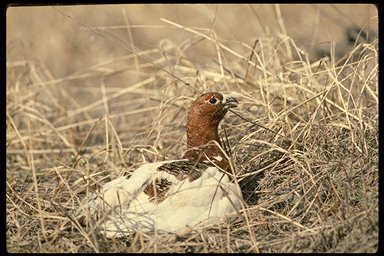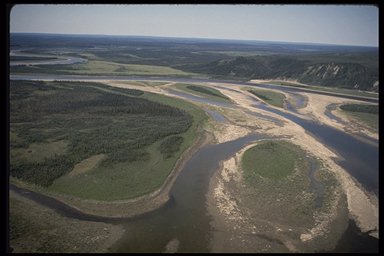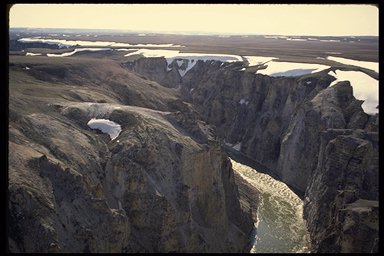
ISLANDS IN A FROZEN SEA
The silence hangs so deep that time itself seems to stand still. Stand on a ridge
like thousands of others on an island like dozens of others and in all directions
there is only stillness and peace. Only the wind moves.

THE LAND:
This is a region of the sea - nowhere in this region of islands can you stand more than 50 kilometres from the sea. Yet despite its proximity to the water, most of this region is polar desert - a frigid, barren rock-strewn land. It is one of the driest regions in the world, receiving less than 11 centimetres of precipitation yearly. Snow may fall in any month, a dry powdery snow that blows like dust on the wind. It accumulates in ravines and valleys where it forms hardpacked drifts that have the consistency of Styrofoam.

Each island that makes up this region has its own character ranging from flat to rugged. The mountains on Melville Island, the largest, reach heights of one kilometre. In contrast, the southwest part of Bathurst Island is a remarkably flat sand and gravel plain.
The north magnetic pole is located in this region.
VEGETATION:
Much of this region has little or no vegetation. Where continuous vegetation occurs, it usually consists of hummocks of mosses, lichens, grasses and sedges. The only woody species, the dwarf willow, grows as a dense twisted mat crawling along the ground. Vast areas appear completely devoid of life from a distance. But lichens and mosses cover the rocks; grasses grow around meltwater puddles, and the hilltops bare of snow are tinted with the warm living shades of red and brown.
WILDLIFE:
For a region sparse in plant life, it boasts a surprising number of animals; polar bear, Peary caribou, muskox, collared lemming, arctic wolf, arctic fox, arctic hare and ermine in small, discontinuous populations concentrated around wet lowlands. Life is tenuous in this region. An early snowfall that melts and then freezes, sealing vegetation beneath a layer of ice, can spell disaster.
Birds are more fortunate. They can fly away when times are rough. Snowy owls depend on lemmings as a food source. But lemming populations fluctuate on a four-year cycle. Luckily for the owls, each island is at a different phase of the cycle, meaning that they can simply fly off to another island where the hunting is good. The arctic foxes are not so lucky.

Birds abound here in summer, especially on the southern islands. The valleys and lowlands, bespeckled with meltwater ponds and puddles, provide nesting habitat for myriads of shorebirds and waterfowl: black-bellied plovers, knots, pectoral sandpipers, king eiders, greater snow geese, brant, oldsquaw and red-throated loon, among others.
The only known nesting site of the ivory gull is found in this region and is protected as Seymour Island Migratory Bird Sanctuary (8 km2).
STATUS OF NATIONAL PARKS
In 1995 the Inuit of Resolute Bay agreed to work with Parks Canada and other government departments to study the feasibility of a national park on northern Bathurst Island. The proposed national park is about 5800 km2 in size and includes those areas of Bathurst Island lying adjacent to and north of the existing National Wildlife Area at Polar Bear Pass.
The proposed national park area represents all the major themes of this harsh natural region - in particular the long cold winters, expanses of exposed bedrock, and very short growing season. Vegetation is sparse and soils are very thin. There is sufficient vegetation, however, to support small populations of muskox and Peary caribou. In fact, the most important calving area for Peary Caribou, an endangered species, is found within the park proposal. There are also several small, isolated archaeological sites.

Consultations with local residents, and studies of mineral and energy resources, cultural resources, tourism potential, and oral history are being initiated. It is expected that about two years will be required to complete these studies and consultations.
Establishment of a national park in this natural region will require the support and cooperation of Inuit and the Government of the Northwest Territories, including the negotiation of an Inuit Impact and Benefits Agreement.
The following table summarizes the status of system planning for each step toward establishing a new national park in this natural region.
| Steps in the Park Establishment Process. | Status |
| Representative Natural Areas Identified: | done |
| Potential Park Areas Selected: | done |
| Park Feasibility Assessed: | underway |
| Park Agreement Signed: | 0 |
| Scheduled Under the National Parks Act : | 0 |